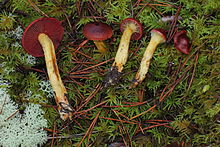
A bolete is a type of mushroom, or fungal fruiting body. It can be identified thanks to a unique cap. On the underside of the cap there is usually a spongy surface with pores, instead of the gills typical of mushrooms. A similar pore surface is found in polypores, but these species generally have a different physical structure from boletes, and have different microscopic characteristics than boletes. Many polypores have much firmer, often woody, flesh.

Cortinarius is a globally distributed genus of mushrooms in the family Cortinariaceae. It is suspected to be the largest genus of agarics, containing over 2,000 widespread species. A common feature among all species in the genus Cortinarius is that young specimens have a cortina (veil) between the cap and the stem, hence the name, meaning curtained. Most of the fibres of the cortina are ephemeral and will leave no trace once gone, except for limited remnants on the stem or cap edge in some species. All have a rusty brown spore print. The common names cortinar and webcap refer to members of the genus. Due to dangerous toxicity of several species and the fact that it is difficult to distinguish between various species of the genus, non-expert consumption of mushrooms from the genus is discouraged.
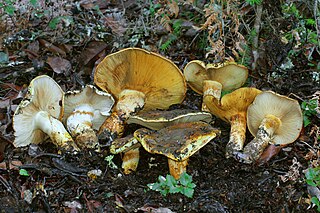
Phlegmacium ponderosum, also known as the Ponderous Cortinarius, is a species of mushroom producing fungus in the family Cortinariaceae. It is very large and due to its thick stem it can be mistaken for Boletus edulis.
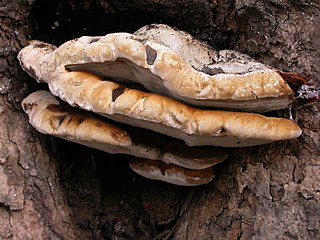
Inonotus arizonicus is a plant pathogen. I. arizonicus is a locally common saprotrophic polypore that induces white rot in sycamore trees in southwestern North America. Host species include Platanus wrightii and Platanus racemosa. The fruiting bodies, shaped like hooves or a plate or a stack of plates, can appear on trunks, at the base of living trees, or on stumps or snags. In California this species is generally found south of the San Francisco Bay Area.
Cortinarius caperatus is an edible mushroom of the genus Cortinarius found in northern regions of Europe and North America. It was known as Rozites caperata for many years before genetic studies revealed that it belonged to the genus Cortinarius. The fruit bodies appear in autumn in coniferous and beech woods as well as heathlands in late summer and autumn. The ochre-coloured cap is up to 10 cm (4 in) across and has a fibrous surface. The clay-colored gills are attached to the stipe under the cap, and the stipe is whitish with a whitish ring. The Latin specific name, caperatus, means wrinkled, and refers to the distinctive texture of the cap. The flesh has a mild smell and flavor.

Boletus barrowsii, also known in English as the white king bolete after its pale colored cap, is an edible and highly regarded fungus in the genus Boletus that inhabits western North America. Found under ponderosa pine and live oak in autumn, it was considered a color variant of the similarly edible B. edulis for many years.

Cortinarius semisanguineus is a medium-sized mushroom with a pale brown to ochre cap, and bright blood-red gills. It belongs to the genus Cortinarius, a group collectively known as webcaps. It is found growing in conifer plantations, and has recently been given the fanciful common name of surprise webcap. In the past it has been called the red-gilled webcap.

Cortinarius violaceus, commonly known as the violet webcap or violet cort, is a fungus in the webcap genus Cortinarius native across the Northern Hemisphere. The fruit bodies are dark purple mushrooms with caps up to 15 cm (6 in) across, sporting gills underneath. The stalk measures 6 to 12 centimetres by 1 to 2 cm, sometimes with a thicker base. The dark flesh has a smell reminiscent of cedar wood. Forming symbiotic (ectomycorrhizal) relationships with the roots of various plant species, C. violaceus is found predominantly in conifer forests in North America and deciduous forests in Europe.
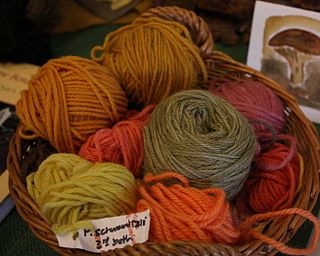
Mushrooms can be used to create color dyes via color-extraction with a solvent as well as particulation of raw material. The shingled hedgehog mushroom and related species contain blue-green pigments, which are used for dyeing wool in Norway. The fruiting body of Hydnellum peckii can be used to produce a beige color when no mordant is used, and shades of blue or green depending on the mordant added. Phaeolus schweinitzii produces green, yellow, gold, or brown colors, depending on the material dyed and the mordant used.

Amanita magniverrucata, commonly known as the pine cone amanita, or great pine jewel, is a species of agaric mushroom in the family Amanitaceae. First described scientifically by American mycologists Harry Delbert Thiers and Joseph Ammirati in 1982, it is mycorrhizal and associates with the tree Pinus radiata, which is commonly known as the Monterey pine.

Amanita augusta, commonly known as the western yellow-veil or western yellow-veiled amanita, is a small tannish-brown mushroom with cap colors bright yellow to dark brown and various combinations of the two colors. The mushroom is often recognizable by the fragmented yellow remnants of the universal veil. This mushroom grows year-round in the Pacific Northwest but fruiting tends to occur in late fall to mid-winter. The fungus grows in an ectomycorrhizal relationship with hardwoods and conifers often in mixed woodlands.

Lichenomphalia umbellifera, also known as the lichen agaric or the green-pea mushroom lichen, is a species of basidiolichen in the family Hygrophoraceae. L. umbellifera forms a symbiotic relationship with unicellular algae in the genus Coccomyxa. It is regarded as nonpoisonous.

Hygrophorus chrysodon, commonly known as the flaky waxy cap, or gold flecked woodwax is a species of fungus in the genus Hygrophorus. It is edible but bland in taste. The species is found throughout the Northern Hemisphere.

Cortinarius sanguineus, commonly known as the blood red webcap or blood red cortinarius, is a species of fungus in the genus Cortinarius.

Aureoboletus flaviporus, commonly known as the viscid bolete, is a species of bolete fungus found in western North America, where it grows in ectomycorrhizal association with coast live oak, madrone, manzanita, and possibly with tanoak. In California, this mushroom appears during the rainy season in locations south of Mendocino County. This mushroom is "fairly common" but does not appear in large groupings, only as one-offs or small clusters in scattered locations.
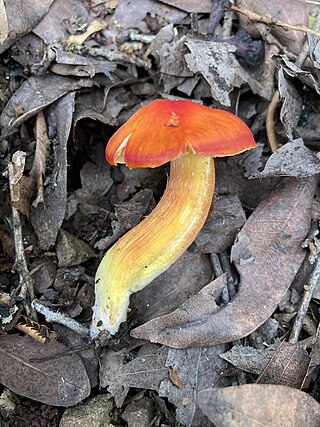
Hygrocybe laetissima, also known as the cherry-red waxy cap, is a species of gilled mushroom found in North America. It appears to flourish in association with redwood forests. The authors of Mushrooms of the Redwood Coast note that this waxy cap is superficially similar to other waxy caps, including Hygrocybe splendidissima, Hygrocybe punicea, Hygrocybe aurantiosplendens, and Hygrocybe marchii. It also overlaps somewhat in range and appearance with Hygrocybe coccinea. This one has the coloration of a Rainier cherry. Not recommended as an edible mushroom because close cousins have made people sick. This mushroom species was first described by Alexander H. Smith and L. R. Hesler.

Russula cremoricolor, also known as the winter russula, is a species of gilled mushroom. This mushroom has red, cream-yellow, and pink color variants, which complicates attempts at field identification, although finding "red and creamy capped fruitbodies in close proximity is a good clue indicating this species". The winter russula is "mildly toxic," and causes intestinal distress even when consumed in small amounts. The red morph was previously identified as Russula silvicola, but was found to be genetically identical to the cream-colored individuals called R. cremoricolor. The red morph is superficially similar to Russula californiensis but R. cremicolor has a much sharper, peppier taste, likes to associate with mixed forest or tanoak rather than pine, and keeps its gills and stipe white even in age.

Calonarius viridirubescens is a species of gilled mushroom. First described to science in 1997, this species was previously classified as Cortinarius viridirubescens, and is thus commonly known as the yellow-green cort.

Entoloma ferruginans is an endemic mushroom of California in North America. It smells distinctly like a chlorinated pool at the YMCA, thus the common name bleachy entoloma. E. ferruginans lives in mycorrhizal association with live oaks south of the San Francisco Bay. This mushroom was first described by Charles Horton Peck in 1895 from a type specimen collected under oak trees in Pasadena.

Hortiboletus coccyginus, commonly known as the sumac-colored bolete, is a species of mushroom in the genus Hortiboletus. It is rare.
